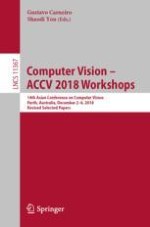This LNCS workshop proceedings, ACCV 2018, contains carefully reviewed and selected papers from 11 workshops, each having different types or programs: Scene Understanding and Modelling (SUMO) Challenge, Learning and Inference Methods for High Performance Imaging (LIMHPI), Attention/Intention Understanding (AIU), Museum Exhibit Identification Challenge (Open MIC) for Domain Adaptation and Few-Shot Learning, RGB-D - Sensing and Understanding via Combined Colour and Depth, Dense 3D Reconstruction for Dynamic Scenes, AI Aesthetics in Art and Media (AIAM), Robust Reading (IWRR), Artificial Intelligence for Retinal Image Analysis (AIRIA), Combining Vision and Language, Advanced Machine Vision for Real-life and Industrially Relevant Applications (AMV).
